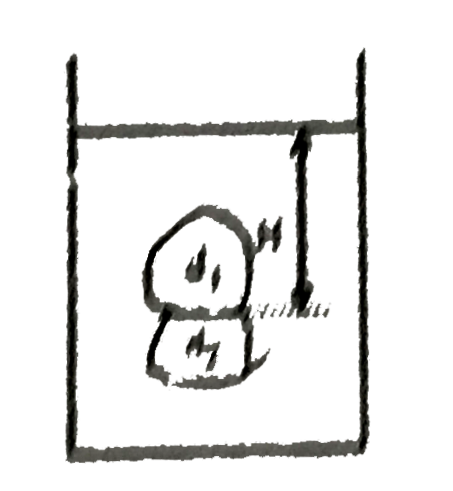Two objects of equal volume V=1m3 and different densities d1=500kg/m3 and d2=1000kg/m3 are gluod to each other so that their contact surface is flat and has an area A=0.1m2 When the objects are submerged in a certain liquid they float in stable equilibrium the contact surface being parallel to the surface of the liquid (see the diagram) How deep (H in meters) can the contact surface be in the liquid so that the objects are not torn apart? The maximum force that the glue can with stand is F=250 N (Neglect atmospheric pressure)

The correct Answer is:3m
At the "critical" depth H, the equilibrium condition for the compound object suggests that the density of the liquid is d=(d1+d2)/2 For the top and the bottom object taken separately, the equilibrium conditions are, respectively
d1Vg+F−(dVg−dgAH)=0
d2Vg−F−(dVg+dgAH)=0
(For each object, the ter, in parentheses indicates the "effective" buoyancy force) Combining the last two equations yields the answer H=[(d2−d1)Vg−2F]/[(d1+d2)gA]
Topper's Solved these Questions
- MASTER PRACTICE PROBLEMBOOK - BANSALCHAPTER - MASTER PRACTICE PROBLEMEXERCISE - Additional topic
70 Videos
- MASTER PRACTICE PROBLEMBOOK - BANSALCHAPTER - MASTER PRACTICE PROBLEMEXERCISE - Multiple objective
131 Videos
- FLUID MECHANICSBOOK - BANSALCHAPTER - FLUID MECHANICSEXERCISE - PYQS AIEEE
10 Videos
- SEMICONDUCTORSBOOK - BANSALCHAPTER - SEMICONDUCTORSEXERCISE - CBSE Question
32 Videos
Similar Questions
Two immisible liquids are pured in a U-tube having densities ρ1=1.0×102kg/m2andρ23.0×102kg/m3. Find the ratio of heights (of the liquids above their interface) n1h2

View SolutionAn object of mass 26 kg floats in the air and it is in the equilibrium state.Air density is 1.3kgm−3. The volume of the object is
View Solution
Knowledge Check
If the surface tension of a liquid is 5 N/m then the surface energy of the liquid film on a ring of area 0.15 m2 is
A1.5JB3.0JC2.25JD0.75JThe surface energy of liquid film on a ring of area 0.15m2 is (surface tension of liquid 5Nm−1)
A0.75 JB1.5 JC2.25 JD3.0 JThe fraction of a floating object of volume V0and density d0 above the surface of a liquid of density d will be
Ad0dBdd0d+d0Cd−d0cDdd0d.d0
The fraction of a floating object of volume V0and density d0 above the surface of a liquid of density d will be
View SolutionTwo immisible liquids are pured in a U-tube having densities ρ1=1.0×102kg/m2andρ22.0×103kg/m3. Find the ratio of heights (of the liquids above their interface) n1h2

View SolutionThe fraction of a floating object of volume V0 and density d0 above the surface of a liquid of density d will be
View SolutionAn object of mass 26 kg floats in the air and it is in the equilibrium state.Air density is 1.3kgm−3. The volume of the object is
View SolutionA sphere of radius 10cm and density 500kg/m3 is under water of density 1000kg/m3 The acceleration of the sphere is 9.80m/s2 upward viscosity of water is 1.0 centipoise if g=9.81m/s2 the velocity of the sphere is
View Solution
